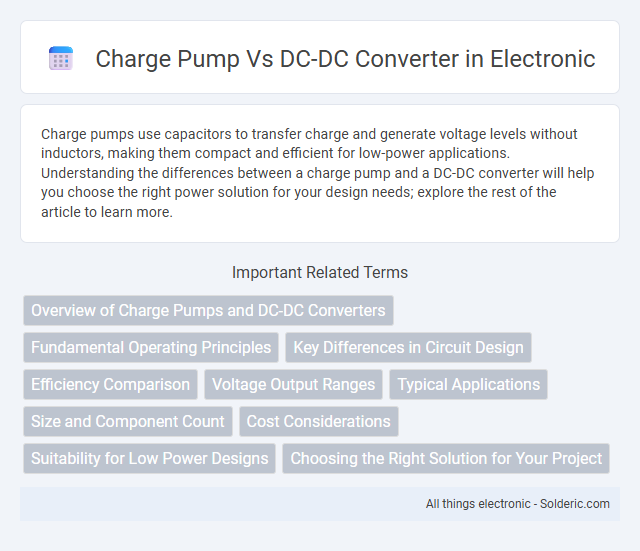Charge pumps use capacitors to transfer charge and generate voltage levels without inductors, making them compact and efficient for low-power applications. Understanding the differences between a charge pump and a DC-DC converter will help you choose the right power solution for your design needs; explore the rest of the article to learn more.
Comparison Table
| Feature | Charge Pump | DC-DC Converter |
|---|---|---|
| Working Principle | Uses capacitors to transfer charge and increase or invert voltage | Uses inductors, switches, and controllers to convert voltage levels efficiently |
| Efficiency | Moderate efficiency (typically 60-80%) at low current | High efficiency (up to 90-95%), suitable for high current loads |
| Output Voltage | Discrete voltage steps (e.g., 2x, 3x input voltage or inversion) | Continuously adjustable output voltage |
| Complexity | Simple circuit, fewer components | More complex due to inductors and control circuits |
| Size | Compact, no inductors required | Larger due to inductors and magnetic components |
| Noise | Lower electromagnetic interference (EMI) | Higher EMI due to switching elements |
| Best Use Case | Low current applications, small voltage boosts or inversion | High power applications requiring efficient voltage regulation |
Overview of Charge Pumps and DC-DC Converters
Charge pumps and DC-DC converters are essential components in power management circuits, each serving distinct roles in voltage regulation. Charge pumps use capacitors to transfer and invert charge, providing efficient voltage doubling or inversion in low-current applications. DC-DC converters, such as buck and boost converters, use inductors and switching elements to deliver precise voltage regulation and higher power efficiency for a broader range of loads, making them suitable for powering complex electronic systems.
Fundamental Operating Principles
Charge pumps use capacitors to transfer and store energy in discrete packets, switching between different configurations to step voltage up or down without inductors. DC-DC converters rely on inductors and switching elements to regulate energy flow, providing efficient voltage conversion with continuous energy transfer. Your choice depends on size constraints and efficiency needs, as charge pumps excel in low-power, compact applications, while DC-DC converters handle higher power demands.
Key Differences in Circuit Design
Charge pumps utilize capacitors to transfer energy through switched capacitor networks, enabling simple and compact circuit layouts with fewer external components. DC-DC converters rely on inductors and switching elements to regulate voltage via continuous energy transfer, resulting in more complex circuits but higher efficiency and better load handling capabilities. The distinct energy storage mechanisms--capacitive for charge pumps and inductive for DC-DC converters--define their fundamental differences in circuit design and application suitability.
Efficiency Comparison
Charge pumps typically offer higher efficiency in low-power, low-voltage applications due to their simple switching architecture and minimal energy loss during charge transfer. DC-DC converters provide better efficiency in high-current scenarios by using inductive energy storage, which reduces voltage ripple and improves power conversion under varying load conditions. Efficiency for charge pumps often ranges from 70% to 90%, while DC-DC converters can achieve 80% to 95% efficiency depending on the topology and load.
Voltage Output Ranges
Charge pumps typically provide fixed or limited voltage output ranges, often doubling or inverting the input voltage, making them ideal for low to moderate voltage applications. DC-DC converters offer a wide range of voltage outputs, including step-up (boost), step-down (buck), and buck-boost configurations, enabling precise voltage regulation across diverse input and output conditions. Voltage output flexibility in DC-DC converters surpasses charge pumps, supporting higher current loads and complex power management systems.
Typical Applications
Charge pumps are commonly used in low-power applications such as voltage doubling in small battery-powered devices, LCD biasing, and integrated circuit level shifting due to their simplicity and noise-free operation. DC-DC converters are preferred in high-power environments including automotive systems, renewable energy setups, and portable electronics where efficient voltage regulation and high current output are crucial. Your choice depends on power requirements and system complexity, with charge pumps suited for small-scale voltage elevation and DC-DC converters for broader voltage conversion needs.
Size and Component Count
Charge pumps are typically smaller and use fewer external components compared to DC-DC converters, making them ideal for space-constrained applications. DC-DC converters require inductors and more complex circuitry, increasing their size and component count. The simpler design of charge pumps leads to reduced PCB area and easier integration in compact electronic devices.
Cost Considerations
Charge pumps offer a cost-effective solution for low-power voltage conversion due to their simple design and minimal component count, reducing overall manufacturing expenses. DC-DC converters, while typically more expensive, provide higher efficiency and better performance for applications demanding greater power levels or voltage regulation. Your choice hinges on balancing budget constraints with power requirements to optimize system cost and functionality.
Suitability for Low Power Designs
Charge pumps excel in low power designs due to their simple architecture and high efficiency at small currents, making them ideal for applications like portable devices and small sensors. DC-DC converters, while versatile and capable of handling higher power, often exhibit greater complexity and lower efficiency at minimal loads, which can lead to unnecessary power loss in ultra-low power scenarios. Your selection should favor charge pumps when minimizing power consumption and circuit complexity is a priority in low power applications.
Choosing the Right Solution for Your Project
Charge pumps provide a compact, noise-free solution for low-power applications requiring simple voltage doubling or inversion with minimal external components. DC-DC converters excel in efficiency and output power scalability for complex, high-current projects requiring precise voltage regulation and wide input voltage ranges. Careful assessment of load current, voltage requirements, size constraints, and efficiency needs determines the optimal power supply method for your electronic design.
charge pump vs DC-DC converter Infographic

 solderic.com
solderic.com